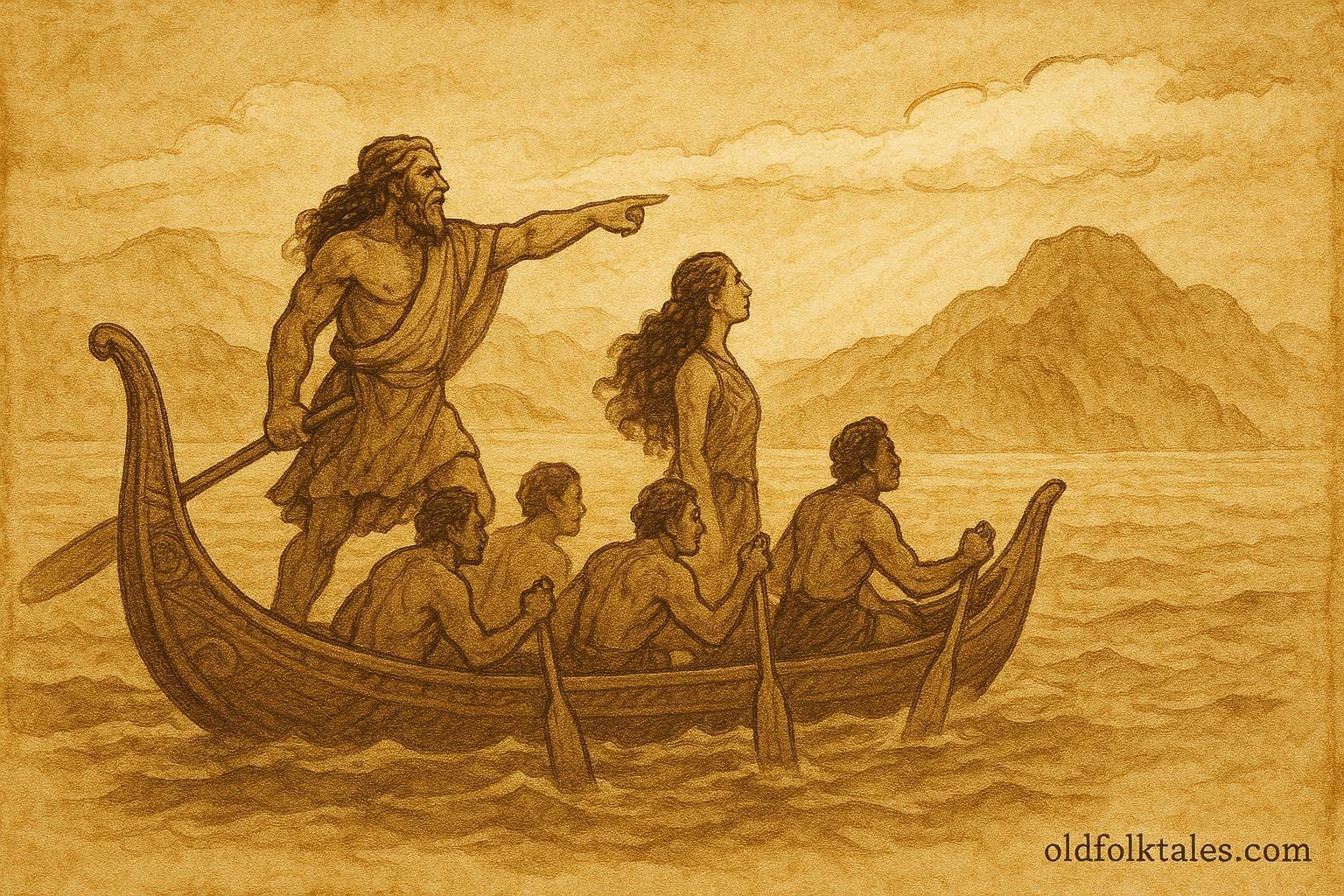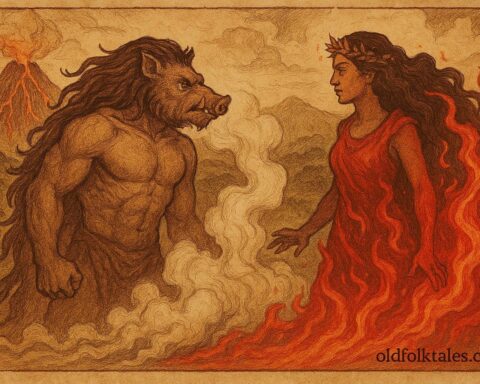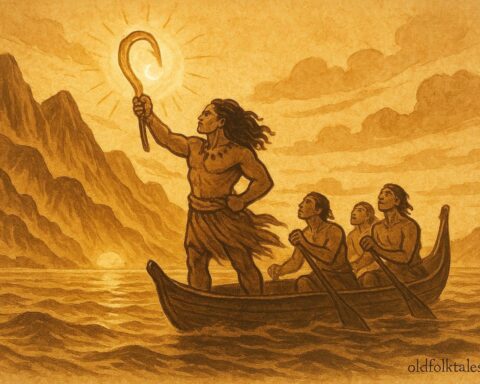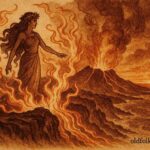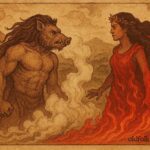Long ago, in the ancient homeland of Hawaiki, there lived a skilled and daring navigator named Kupe. He was known across the islands for his mastery of the sea, his ability to read the stars, the winds, and the songs of the waves. In those times, the ocean was not merely water; it was a living force, filled with spirits, challenges, and mysteries. And it was upon this vast expanse that Kupe would undertake a journey that would forever shape the destiny of his people.
The Threat from the Deep
Kupe’s story began with conflict. In the waters surrounding Hawaiki, there lived a monstrous creature, a giant octopus called Te Wheke-a-Muturangi, said to be the familiar spirit of a rival chief, Muturangi. This great wheke terrorized fishermen, devouring their catches and damaging their canoes. The people lived in fear, unable to harvest the bounty of the sea that had sustained their ancestors.
Kupe, courageous and resolute, vowed to end this menace. He prepared his great canoe, the Matahourua, a vessel crafted with sacred rituals and carved with symbols of the ancestors. His wife Hine-te-Aparangi, a woman of wisdom and vision, joined him, as did his crew, warriors and navigators skilled in the ways of the ocean. Together, they set sail, their hearts steady against the roaring surf.
The Pursuit Across the Great Ocean
The pursuit of Te Wheke-a-Muturangi was no ordinary chase. The creature fled across the endless ocean, and Kupe followed, guided by the stars and the spirits of his ancestors. Days turned to nights, and nights into weeks. The ocean tested their endurance with fierce winds and towering waves, but Kupe’s leadership never faltered.
Each dawn, he studied the rising sun and the flight of seabirds. His wife watched the clouds and sea color, reading omens of land or danger. The crew paddled tirelessly, chanting rhythmic songs that kept their courage strong. They sailed through regions of calm waters and treacherous storms, through silence and thunder, always chasing the shadow of the monstrous wheke beneath the waves.
Then, one morning, when the air was still and the sea glowed with the color of jade, Kupe saw something in the distance, a long, mist-covered coastline rising from the horizon.
“He ao! He ao! He ao tea, he ao marama!”, “A cloud! A white cloud! A bright, shining cloud!” cried Hine-te-Aparangi.
From her words came the name Aotearoa, The Land of the Long White Cloud.
The Discovery of Aotearoa
Kupe and his people drew closer to this new land, marveling at its mountains, forests, and rivers. Birds unknown to them filled the skies, and the scent of new soil carried on the breeze. They anchored their canoe at places now known as Hokianga and Marlborough Sounds, exploring the bays and inlets. Everywhere they went, Kupe gave names to the landmarks, mountains, rivers, and islands, leaving a map of memory for those who would follow.
The people found the land rich and abundant. Fresh waters flowed from the hills, and forests teemed with life. Yet Kupe remained vigilant, for the wheke still lurked somewhere in the depths. One day, at a place now called Te Whanganui-a-Tara (Wellington Harbour), the monster rose from the deep. Its tentacles lashed the waves, and its eyes burned like molten stone.
Kupe shouted commands to his warriors, and the battle began. The sea churned with foam and fury as they struck at the creature with spears and clubs. Kupe himself leapt upon the prow of his canoe, calling upon the gods of the wind and sea. With a final, mighty blow, he struck down the great wheke. The waters stilled. The people rejoiced. The seas, at last, were safe.
The Journey Home
Having vanquished the wheke and discovered a land of promise, Kupe’s heart turned toward Hawaiki. He knew that this new land was a gift meant for his descendants, a place where his people could find new beginnings. Before he left, he marked sacred stones and placed them along the shores, so future voyagers would know that Kupe had come before them.
He gathered his people aboard the Matahourua and sailed home, retracing the pathways of the winds. The ocean, once filled with danger, now seemed a friend, whispering the stories of their journey. When they reached Hawaiki, Kupe told his people of the new land across the sea, Aotearoa, describing its beauty and bounty. He urged them to follow, to carry the light of their ancestors to this new world.
In time, generations after Kupe, others would set sail from Hawaiki, guided by his words and memory. They would find Aotearoa and settle there, fulfilling Kupe’s vision and giving birth to the Māori people’s deep connection to both the land and the sea.
Moral Lesson
The legend of Kupe teaches the value of courage, leadership, and vision. True discovery requires faith, in oneself, in one’s people, and in the unseen paths that lie beyond the horizon. Kupe’s journey reminds us that the greatest explorers are those who follow both the stars and the spirit within.
Knowledge Check (Q&A)
- Who was Kupe in Māori tradition?
Kupe was a great navigator and explorer from Hawaiki, credited with discovering Aotearoa (New Zealand). - What was Te Wheke-a-Muturangi?
It was the giant octopus belonging to Muturangi, Kupe’s rival, which he pursued across the ocean. - How did Aotearoa get its name?
Hine-te-Aparangi, Kupe’s wife, saw a white cloud above the new land and exclaimed “A cloud! A long white cloud!”,giving rise to the name Aotearoa. - What did Kupe do after discovering Aotearoa?
He explored and named its landmarks, defeated the sea monster, and then returned to Hawaiki to guide his people toward their future home. - What are the main themes of the legend?
Courage, leadership, discovery, and the spiritual connection between people and the natural world. - What moral lesson does Kupe’s voyage teach?
That great journeys begin with faith, determination, and respect for the world’s guiding forces.
Source: Adapted from “The Lore of the Whare-Wānanga” by H.T. Whatahoro, translated by S. Percy Smith (1913)
Cultural Origin: Māori (Aotearoa/New Zealand)
